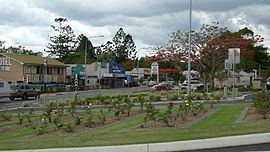Population 1,190 (2011 census) Local time Tuesday 12:28 PM | Postcode(s) 4671 Postal code 4671 | |
 | ||
Weather 33°C, Wind E at 13 km/h, 48% Humidity | ||
Gin Gin is a small town and rural locality in the Bundaberg Region, Queensland, Australia.
Contents
- Map of Gin Gin QLD 4671 Australia
- History
- Heritage listings
- Economy
- Education
- Events
- In popular culture
- Population data
- References
Map of Gin Gin QLD 4671, Australia
It is located on the Bruce Highway, approximately 51 kilometres (32 mi) west of Bundaberg and 370 kilometres (230 mi) north-west of Brisbane, the state capital. The town owes its existence to its strategic location about halfway between Brisbane and Rockhampton. It is often used as a stop-over point for drivers travelling between these two centres. In the 2011 census, Gin Gin had a population of 1,190 people.
History
The town name Gin Gin was derived from the original station name, which used a local Aboriginal word indicating "red soil thick scrub".
The Gin Gin district was originally settled in 1847 when Gregory Blaxland and William Forster moved into the area with sheep and cattle. The site where the town now stands was once part of the sprawling Gin Gin Station owned by Sir Thomas McIlwraith, who was Premier of Queensland three times between 1879 and 1893.
The Gin Gin district is nicknamed Wild Scotsman Country due to the capture of one of Queensland's few bushrangers, James Alpin McPherson, in the area on 30 March 1866. McPherson, who went by the same nickname, was captured at Monduran Station, 13 kilometres (8.1 mi) north of town.
Gin Gin Post Office opened on 15 March 1875.
Gin Gin Provisional School opened on 26 June 1882. It closed on 31 October 1890 to be replaced by Gin Gin State School which opened on 3 November 1890 with 8 students under teacher Arthur William Moore. In 1956, the school expanded to offer secondary schooling, until a separate Gin Gin State High School was established on 1 February 1972. Gin Gin State Pre-School opened on 25 October 1977 and closed in 2006 when it was absorbed into Gin Gin State School.
Heritage listings
Gin Gin has a number of heritage-listed sites, including:
Economy
Gin Gin, like Bundaberg, is heavily dependent on the sugar industry, with sugarcane plantations dotted throughout the area. The Gin Gin Sugar Mill is situated at the nearby locality of Wallaville. An extensive system of sugar cane tramways service the area. Cattle production also features prominently. In recent years small cropping has taken off across farms in the district, with varied success.
Education
Gin Gin State School opened in 1882 with only one teacher in one building. Now it caters for around 450 students, mainly of rural background. As well as the students from Gin Gin itself, many students travel, mainly by bus, from surrounding properties and townships like Wallaville, Bullyard, Tirroan, McIlwraith, Maroondan and Mount Perry.
Events
The Wild Scotsman Festival used to be held in Gin Gin on the third week of March each year to commemorate the capture of the bushranger James MacPherson. The Wild Scotsman Markets are held next to the historical Grounds each Saturday morning.
In popular culture
Gin Gin is the eighteenth town mentioned in the original (Australian) version of the song "I've Been Everywhere".
Population data
At the 2006 census, Gin Gin had a population of 892.
